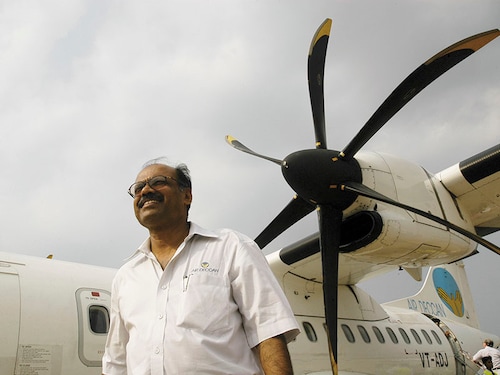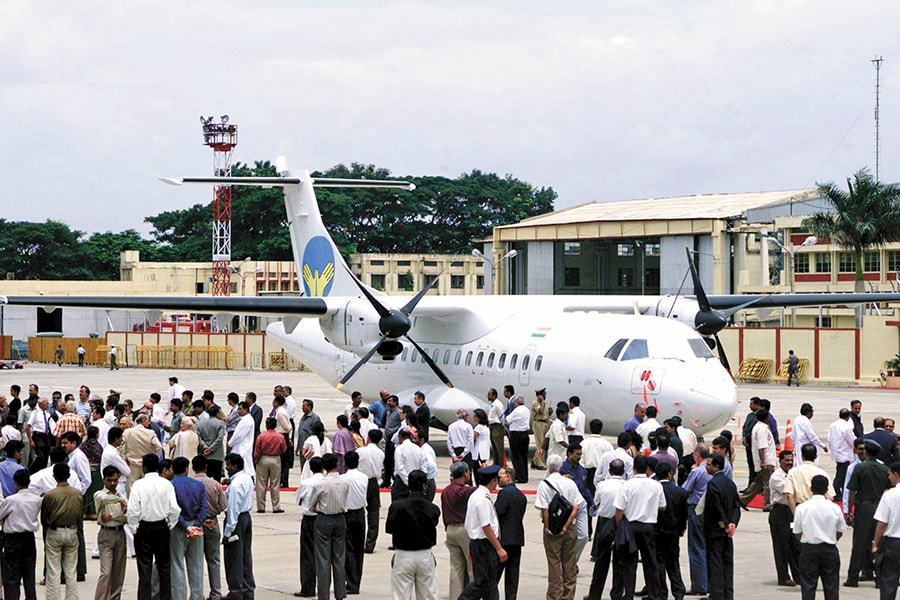Air Deccan: Back in the skies
With smaller aircraft and strategic tie-ups, Air Deccan's Captain GR Gopinath is having another go at commercial aviation. Will he be second time lucky?


Image: Bandeep Singh / The India Today Group / Getty Images
On December 23, 2017, Captain Gorur R Iyengar Gopinath re-entered India’s commercial aviation market, a decade after he had exited from it. With the launch of three flights from Mumbai—to Nashik, Pune and Jalgaon—Gopinath, fondly known as Captain or Gopi, and his airline entity Air Deccan, which made budget air travel in India a reality back in 2003, were back in the game.
Budget airlines or low-cost carriers (LCCs), which charge for traditional services such as food and seat allocation and offer low fares, function on a different revenue model as compared to traditional airlines. In 2003, when Gopinath had launched Air Deccan, there were only four airlines—Jet Airways, Air Sahara (which was bought by the former), Air India and Indian Airlines (the latter two have merged since then)—and all were, and continue to be, traditional full-service airlines. Today, LCCs command a 65 percent share of India’s domestic air passenger traffic.
Amber Dubey, partner and India head of aerospace and defence at KPMG, points out that Captain Gopinath “is the pioneer of the LCC concept in India”. “He provided regional connectivity when the term was not a buzzword,” says Dubey.
It’s a different story though how another budget carrier IndiGo, which launched operations three years after Air Deccan, has become India’s largest and most profitable airline with a 40 percent share of the domestic air passenger traffic while Air Deccan bowed out in 2007. This despite having scaled and achieved over 20 percent market share in four years. The airline was making huge losses and early investors of Air Deccan were pressuring Gopinath for an exit. “Air Deccan succeeded, it did not fail. It sold to [Vijay Mallya’s] Kingfisher [Airlines] because of investor pressure,” says Gopinath, adding, “And everybody who invested made huge returns.”
Gopinath, however, managed to retain the name Air Deccan by registering for it soon after Mallya rebranded it as Kingfisher Red. Even though he had no intention of relaunching the airline at the time considering he had signed a six-year non-compete agreement with Mallya, he wanted the brand back. “It [Air Deccan] was a brand he [Mallya] had abandoned and which he did not renew. He had no interest in it,” says Gopinath. “He felt Kingfisher was a brand that was powerful [given its dominance in the beer market]. So by changing Air Deccan to Kingfisher he imagined he could get a better price per seat. That was his notion without realising that Air Deccan stood for something else. When he abandoned it, I registered for it [with Office of the Registrar of Trade Marks] some time back.”
The Deccan brand, meanwhile, continued to exist through Deccan Charters, Gopinath’s air-charter and aircraft maintenance company, which he started in 1997 and which Air Deccan is now part of. In 2009, he started a cargo airline Deccan 360, which wound up in two years. A graduate from the National Defence Academy at Pune and from the Indian Military Academy in Dehradun, Gopinath also unsuccessfully contested the 2009 general election as an independent candidate from the South Bengaluru constituency. Until regional air connectivity to India’s tier 2 and 3 cities driven by the Union government’s Regional Connectivity Scheme (RCS) once again brought him back into the country’s commercial aviation arena.  Air Deccan used a 48-seater ATR for its first commercial flight in August 2003
Air Deccan used a 48-seater ATR for its first commercial flight in August 2003
Image: Jagadeesh N.V. / Reuters
Through RCS, more commonly known as Udan (Ude Desh ka Aam Naagrik), the government is seeking to make flying affordable for the masses. Under the scheme, the government has capped airfares (that are indexed to inflation) at ₹2,500 for a one-hour flight or for a distance of 500 to 600 kilometres, provided huge tax benefits on fuel and given airlines concessions on electricity, water and other utilities at regional airports.
Designated RCS routes are offered to airlines through a formal bidding process, whereby the airline that shows the lowest cost of operating a flight on a particular route wins the bid. The airline gets exclusivity on the route for three years and is given a government subsidy as well. The first round of bidding for 128 RCS routes took place in March last year, and Air Deccan won 34 of the routes.
“I as an entrepreneur am an optimist. Optimism is the essence of entrepreneurship,” Gopinath tells Forbes India in a telephonic interview of his re-entry into commercial aviation. At 66, Gopinath says he is making one final attempt to make it big in India’s aviation market, which has been growing between 15 and 20 percent in terms of passenger traffic over the last three years.
“Gopinath’s return to regional operations should be welcomed as he comes with the experience of having run an airline,” says Jitender Bhargava, former executive director, Air India. “His [Gopinath’s] earlier stint is bound to have taught him what not to do, and also to not be over-ambitious,” he adds. Gopinath clearly knows his mistakes as he says, “I scaled up very fast and that had its own kind of pressures like cash burn.” This time, he adds, “We will grow in a steady manner.”
A new strategy
Air Deccan’s first commercial flight, in August 2003, was from Bengaluru to Hubballi, a tier 2 city in Karnataka, with a 48-seater ATR, a twin-engine fixed-wing turboprop aircraft. By 2007, the airline was flying to 70 destinations in India and operated a dual fleet of over 45 aircraft consisting of the 180-seater jetliner Airbus 320 and the smaller ATR, which flew on regional routes. Says Gopinath, “Between 2003 and 2007, almost all the routes that have now come under Udan were flown by Air Deccan. For example, we had flights to Bellary, Mysore, Vijaywada, Belgaum, Kolhapur, Gwalior, Kanpur, Rajahmundry, and Kullu, among other destinations.”
Gopinath’s model back then was that Air Deccan’s ATRs would act as feeders—bringing people from tier 2 cities to the metros—to its larger A320s which flew on the major trunk routes. And, of course, the LCC concept of low airfares. His aim was to fill every seat in an aircraft.
undefinedAir Deccan has won the bids for 34 routes under the Regional Connectivity Scheme[/bq]
“When I started Air Deccan, the average occupancy of airlines was only 55 percent,” says Gopinath. Reason: Prohibitively high ticket prices. Gopinath recalls that in 2002, a Bengaluru to Delhi one-way ticket sold for ₹12,500. “If the seat was empty, the airline would let it be empty because there was a class barrier there.” That class barrier is what Air Deccan broke.
Today, the landscape has changed with several other LCCs like SpiceJet and IndiGo. And now, the cheapest one-way Bengaluru-Delhi air ticket costs between ₹4,300 and ₹5,800.
In its second outing, Air Deccan continues to be an LCC and Gopinath’s penchant for offering ₹1 fares to entice travellers, also continues. However, considering the airline is only serving RCS routes—flights to tier 2 and 3 cities where airport infrastructure is not great—and not trunk routes like a Mumbai-Delhi or Delhi-Bengaluru, he’s operating with a twin-engine fixed-wing turboprop Beechcraft 1900, a 19-seater aircraft that is widely used for regional air connectivity in America and Africa.
“It can land at airports where the runway length is not sufficient [for even an ATR to land],” says Gopinath. He adds that at airports like Mysuru and Ballari, ATRs cannot land if they are carrying a full load of 72 passengers. A short runway length means there are restrictions on the landing and take-off weight of an aircraft. Similarly, as the Shimla airport is at an altitude of over 7,000 feet above sea level, the ATR cannot land with a full load. “Keeping all this in mind, we went with a 19-seater aircraft,” he says. However, the Beechcraft 1900 is an old generation of aircraft that was in production between 1982 and 2002. Over 600 such aircraft were produced and continue to be in service.
At present, Air Deccan has two Beechcraft 1900 with plans to add close to 12 aircraft over the next six months which would allow the airline to connect to 62 regional airports. The expansion will also be aided by Air Deccan’s recent partnership with another regional airline Air Odisha, based out of Bhubaneswar. According to Gopinath, it is a ‘strategic tie-up’ whereby Air Deccan will manage a host of functions for Air Odisha such as aircraft procurement, leases, and maintenance, IT systems, pilot and engineer training, flight operations, and inventory management, while both airlines will operate as two separate entities. Air Odisha has won 50 RCS routes, so that gives the airlines a combined network of 84 RCS routes. Air Odisha is still awaiting its flying permit from the Directorate General of Civil Aviation.
Gopinath thinks the collaboration will ensure economies of scale, especially in key areas such as flight operations and training of personnel. Bhargava, though, is of the opinion that established airlines like IndiGo, SpiceJet and Alliance Air will “undoubtedly enjoy an edge” over standalone operators like Gopinath. “Due to their elaborate network, they will appeal more to passengers, resulting in higher load factors and thereby enhanced revenues,” says Bhargava.
Kapil Kaul, CEO, CAPA South Asia, an independent aviation consulting, research and knowledge practice firm, is also sceptical of whether standalone regional operators can succeed. “I don’t see regional operators making it work with sub-scale operations, significant under capitalisation and operating a very old fleet [of aircraft]. This, coupled with slot challenges at metros [airports] and a resultant dispersed network, will make it very difficult [for them] to achieve viability.”
But Gopinath is optimistic that his second innings will be successful. “When I first started Air Deccan, there were zero concessions on fuel. Now, there are zero taxes on fuel, there is a three-year exclusivity of routes and a 50 percent government subsidy. These combinations would make it viable,” he asserts.
Is RCS viable?
The airline business works on high volumes and low margins. Hence, an RCS airline operator needs to have a robust scale-up plan in place before the government’s three-year financial subsidy period under Udan runs out. But considering regional airlines like Air Costa and Air Pegasus ceased operations since July 2016 due to financial troubles, the question arises about whether there is a viable regional air connectivity model that can be tapped into.
So, besides the question of whether Gopinath can achieve success, the question is also whether Udan itself makes great business sense. KPMG’s Dubey believes it does. “Else a leading player like IndiGo would not disrupt its single-aircraft fleet strategy [of A320s] and go for turboprops [ATRs]. And SpiceJet would not order another 50 turboprops [Bombardier Q-400s] and talk of 100 seaplanes on top of that,” says Dubey. According to him, Delhi and Mumbai have less than 5 percent of India’s population, but nearly 40 percent of India’s air traffic. “There are dozens of places of significant importance in the interiors of India from a population, tourism and industry perspective, but they lack air connectivity since there was no fiscal or monetary support.”
Earlier, from a politician’s point of view, supporting the aviation sector was risky as it was a rich man’s mode of transport. That seems to have changed. Udan’s success, according to Dubey, now depends on factors such as the robustness of an airline’s strategy, business plan, operations and human resources. Says CAPA’s Kaul, “Making it work will be very challenging but I sincerely hope that Captain makes it big.”
First Published: Jan 22, 2018, 06:46
Subscribe Now